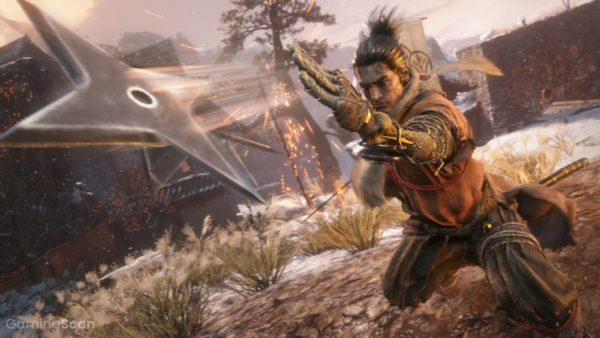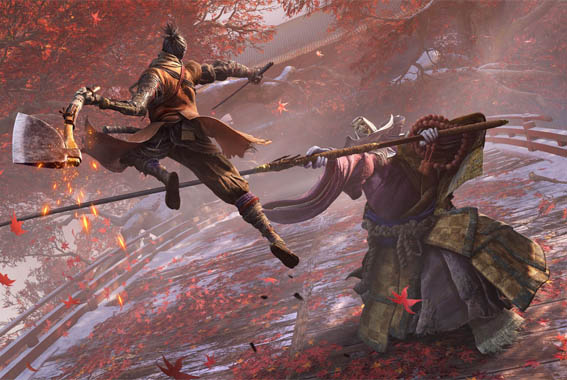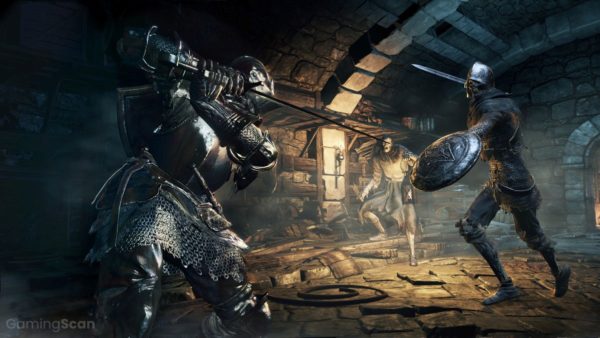Bottom Line
Overall, Sekiro is one of those games that will be remembered and replayed a lot in the coming years and is also one that every Souls veteran will likely want to have proudly displayed on their shelf.
It has some of the best combat ever seen in a Souls-like game, though its sheer difficulty and some recycled boss fights can occasionally take away from the experience.
The Pros:
- Most difficult Souls-like game so far
- Exhilarating fast-paced combat
- Focus on skill instead of stats
- Large, open levels ripe for exploration
- Amazing art direction and soundtrack
The Cons:
- Most difficult Souls-like game so far
- Some recycled bosses
- Story not quite as captivating as Dark Souls or Bloodborne
W reAh, Sekiro. I remember when the first teaser came out, and everyone thought it was Bloodborne 2. When it turned out that the cryptic phrase that followed the teaser was to be the subtitle of an entirely new IP, I was a bit disappointed – that feeling, of course, was not long-lived.
Sekiro: Shadows Die Twice is a bit of a departure from FromSoftware’s usual Souls-like formula, not only in terms of mechanics but also when it comes to the storytelling techniques.
Unlike the previous games, it is not an RPG but an action-adventure with some RPG elements, focusing more on pure skill without any cumbersome stats that the player has to worry about.
But without further ado, here’s what we think of FromSoftware’s addition to their long list of extraordinary games!
Table of ContentsShow
The Story
Unlike Demon’s Souls, Dark Souls, and Bloodborne, which are set in completely fictional worlds, Sekiro is rooted in the real world, albeit a greatly fictionalized version thereof.
It takes place after the Sengoku period – a time of great strife and conflict in medieval Japan. More specifically, it is set in the lands of the Ashina clan, where the warlord Isshin Ashina seized control of the land twenty years before the events of the game.
The player takes over the role of the main protagonist, a war orphan trained to become a shinobi, now sworn to serve the Divine Heir Kuro. This is where the theme of immortality, death, and rebirth once again finds its way into Hidetaka Miyazaki’s work.
Namely, Kuro is immortal and cannot be killed due to the “Dragon’s Heritage.” To put it simply, the Divine Heir cannot be harmed or killed, and he can bestow the gift/curse of immortality upon others.
This is precisely why the protagonist can return from death and why Genichiro Ashina, the main antagonist and the grandson of Isshin Ashina, wants to “make use of his bloodline” in an attempt to save the Ashina clan from destruction at the hands of the fictionalized Japan’s government.
After Genichiro cuts the protagonist’s arm off and takes Kuro away, the player’s immediate task is rescuing the master from those who seek to exploit his incredible power for their gain.
As the story unfolds, the player has the opportunity to make certain decisions, which will ultimately affect the course of the game, leading to one of a total of four endings.
The story is generally more straightforward, and the dialogues are less cryptic than what Dark Souls/Bloodborne fans are used to, which may be a good or a bad thing based on how you look at it.
In any case, seeing as it once again deals with a land mired in conflict and burdened by a curse of immortality, the story of Sekiro doesn’t stray too far from the Soulsborne themes that we’re used to.
The Gameplay
The Basics
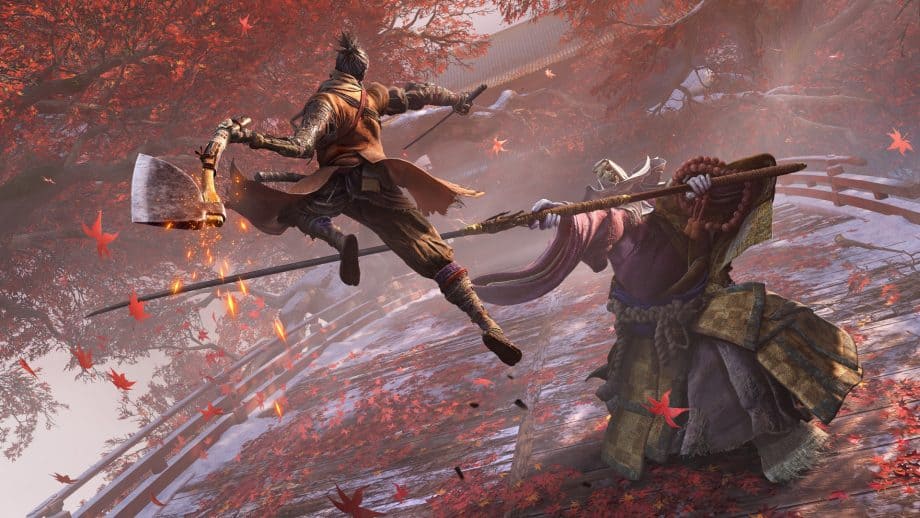
The most important way that the combat of Sekiro differs from the combat systems of Demon’s Souls, Dark Souls, and Bloodborne is the elimination of the stamina bar, which was the staple of every Souls-like game up to this point, and it was replaced by the posture bar.
Another brand-new addition to the Souls-like subgenre is the jumping mechanic. Complemented by the grappling hook, it makes the player extraordinarily mobile. It adds a whole new dimension to exploration, allowing for levels that are more open than those in any of the previous games.
On top of that, basic stealth mechanics are also introduced, and the player is encouraged to take advantage of stealth when facing groups of enemies, especially if it is in boss arenas.
Instead of heavy attacks, the player has various shinobi tools at their disposal. These are fitted onto the signature prosthetic arm. A maximum of three shinobi tools can be equipped at a time, though they can easily be switched at any point in the pause menu.
Nearly all of the shinobi tools are hidden away from the beaten path, so if you’re not keen on exploration, you could miss many of them entirely.
Another extra dimension to the combat is the combat arts and the ninjutsu techniques. The player can have only one of each equipped at a time, but much like shinobi tools, they can be swapped anytime.
The former is simply special combat moves with different applications, while the latter is executed as follow-ups to backstabs that offer brief advantages in combat.
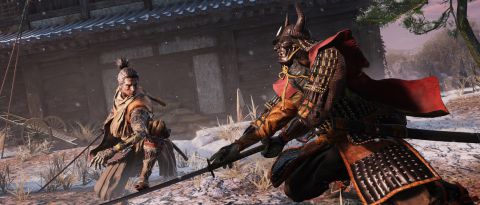
Now, all shinobi tools, all ninjutsu techniques, and several combat arts require the use of a varying number of spirit emblems. These can be acquired from fallen enemies, found floating in the environment, or they can be bought rather cheaply at any bonfire – ahem, sculptor’s idol.
In any case, hoarding these isn’t a problem, but since you can only have a limited number of them on you, it means that a reasonable strategy is required when it comes to using abilities that consume them.
The XP/currency system has been revamped, too. Where before we had souls and blood echoes filling the role of both, XP points and currency are separate in Sekiro.
By killing enemies, the player accumulates XP, which grants them skill points that can then be spent on various skills across several skill trees. Just the same, killing enemies yields Sen, coins that can be spent either on items sold by many merchants or on the spirit emblems mentioned above, which can be bought at any idol.
Finally, there’s the penalty for dying, which is different as well. Famously, Dark Souls and Bloodborne had you losing all your souls/echoes upon death, and if you were to die again before reclaiming them, all that precious XP would be lost permanently.
In Sekiro, however, you only lose half of your XP and half of your Sen upon death – these are lost permanently and cannot be reclaimed. But unspent skill points are never lost, and there is always a small chance that you may receive “unseen aid” upon death and not lose anything at all.
That’s the gist of it. Now, let’s go into more detail!
Posture, Dodging and Deflection
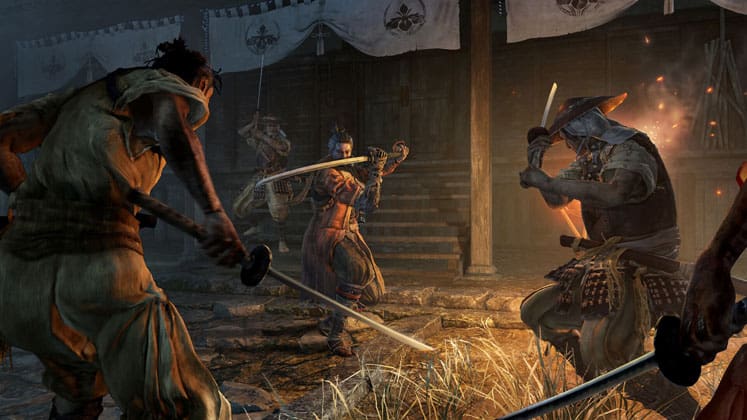
As mentioned above, one of the most significant combat-affecting changes was the replacement of the stamina gauge with the posture meter. Unlike stamina, the posture meter fills up instead of depleting as the fight goes on.
The posture meter is filled up by taking damage, as well as by blocking enemy attacks – the same goes for every single enemy in the game. However, the quickest way to fill up a posture meter is through parrying – or deflection, as it is called in Sekiro.
Namely, a well-timed block will deflect an enemy’s attack, filling up their posture meter significantly and bringing them closer to a potentially lethal deathblow.
So, how does this reflect on the combat?

Well, let’s just say that it makes the game incredibly dynamic and fast-paced, encouraging a more aggressive playstyle. No longer do you have to worry about dodging or running depleting your stamina.
However, if you get greedy and too keen on spamming R1/RB, the enemy will still punish you with either a nasty deflection or a devastating counter-attack that you won’t be able to avoid.
Now, deflecting enemy attacks is preferable to dodging in most cases. In Sekiro, there are two ways that you can dodge an attack: a simple Bloodborne-Esque sidestep or a jump.
The former is a short-range evasion that is good if you want to launch an immediate counter-attack, while the jump gets you a bit further away from an enemy and is an excellent way of dodging sweeping attacks.
In addition to that, jumping towards an enemy and then jumping again allows the player to jump-kick them, which can both get you out of a bind and damage an enemy’s posture.
But that’s not all – Sekiro also has some other forms of defense, such as the Mikiri Counter that’s acquired soon after the start of the game and is used to counter thrust attacks which cannot be blocked or deflected by usual means.
Plus, there are also defensive shinobi tools such as the Umbrella Shield or the Mist Raven that allow for more efficient blocking and dodging.
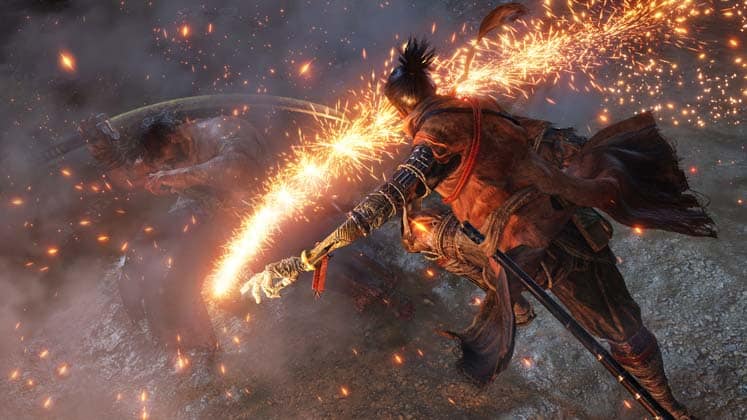
When an enemy’s posture is broken, they are rendered open for a deathblow – an instant kill that comes with some potential extra unlockable perks such as regenerating a small portion of your health.
Bosses are vulnerable to deathblows, too, which is why most bosses have at least two health bars.
Sekiro rewards aggression, but it also requires the player to be extremely focused and mindful because you will need to make use of different techniques to counter different moves.
All that it takes is one delayed attack or an overly fast attack in a combo to get you to miss the time of your deflection and wreck your posture, all the while trying to block a “perilous attack” such as a sweep or grab will not end well.
Overall, between the fluid movement and a great focus on tense, fast-paced encounters, the game is so fast and adrenaline-inducing that it puts Bloodborne to shame.
If you’ve mastered parrying in the previous games, you will have a field day with Sekiro, but if you haven’t, you will have to face a bit of a steep learning curve.
Leveling
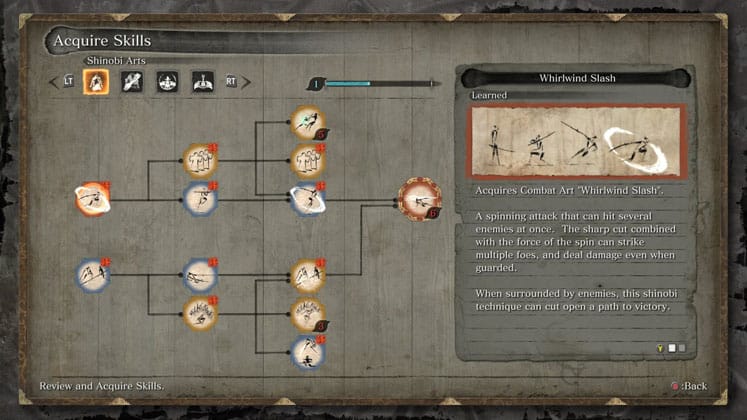
The RPG elements are heavily toned-down in Sekiro. There is no character customization, and only a semblance of stats remain, but in any case, leveling is a lot simpler.
Regarding the player’s stats, there are only three: health, posture, and attack power. Health and Posture are increased by using prayer beads, an item that is mainly dropped by optional bosses and minibosses, though some can be found in the environment or bought from merchants.
Meanwhile, attack power can be increased by “facing memories” of battles with formidable foes, specifically using the unique items dropped by the main bosses.
Then, there are the skill trees. We’ve already mentioned that XP works a bit differently here: it is accumulated by killing enemies, and “leveling up” leads to the player being awarded a single skill point that can be spent at any idol and cannot be lost by dying.
Initially, there is only a single skill tree, but other skill trees can be unlocked as the game progresses. These skill trees hold both active and passive abilities. This includes combat arts, special moves, and combos, but also specific passive boosts such as improved stealth or a permanent increase to the number of spirit emblems that can be carried at a time.
Overall, some skills are instrumental and, I’d say, almost indispensable, while others can feel rather trivial.
In any case, leveling in Sekiro is easier than in previous FromSoftware games since there is no threat of losing unspent skill points by dying. When you do spend them, you are spending them on specific abilities rather than on increasing stats.
Shinobi Tools, Combat Arts, and Ninjutsu Techniques

As stated above, shinobi tools replace heavy attacks in Sekiro, and they are highly reminiscent of Bloodborne’s trick weapons, albeit their special abilities are not bound to specific weapons.
That, combined with the fact that you can cycle between three different tools in real-time and swap them out at any point in the pause menu, makes the shinobi prosthetic arm very versatile.
There are ten shinobi tools in the game at the moment, but most of them are entirely optional, and it’s very easy to miss them if you’re not exploring the levels thoroughly.
Furthermore, when it comes to their usefulness, shinobi tools are something of a hit-and-miss in that there are some handy ones that you basically can’t play the game without. In contrast, other disappointingly non-versatile ones can only really be useful in specific situations.
Then, we have combat arts, which are essentially special moves with different applications, similar to the weapon arts of Dark Souls III. And while they may not seem overly impressive, using the right weapon art can make encounters a lot easier.
For example, the circular Whirlwind Slash is great for quickly clearing out groups of weak enemies or for getting you out of a tight spot, the slow but powerful Ichimonji vertical strike is excellent for inflicting substantial posture damage, while the Nightjar Dash can help you close in or get away from enemies quickly.
And finally, there are the ninjutsu techniques, which add a follow-up action to a backstab and give the player a brief advantage in combat. There are only three of them in the game for now: Bloodsmoke, which shrouds the area in smoke and stuns enemies; Puppeteer, which turns an enemy into a temporary ally; Bestowal, which bestows the player’s sword with a longer attack range in the form of blood trails that follow each stroke of the sword (bound to bring a smile to the face of any Lady Maria fan).
Death, Resurrection, and Dragonrot

“Shadows Die Twice” – the line is there for a reason, though in the game, you can die more than twice, all thanks to the Dragon’s Heritage, which the Divine Heir bestows upon you.
Every time a player dies, they can decide whether they want to die and respawn at the last idol they rested at or to resurrect immediately with half their health bar.
There is one main resurrection node which allows the player to resurrect once per spawn and is refreshed when the player respawns or rests at an idol.
However, additional resurrection nodes exist.
After the player resurrects once, they need to execute one or more deathblows to unlock the resurrection ability again. After it is unlocked again, the resurrection ability uses one of the extra resurrection nodes.
Unlike the main node, the additional nodes do not reset automatically after death or after resting. Instead, they need to be filled up by executing enemies with deathblows. The player starts with only one extra node, but another one can be unlocked further into the game.

Now, apart from potentially losing half of your XP and Sen permanently upon death, there is another penalty for repeatedly dying: Dragonrot.
It starts spreading after the player dies and returns to an idol a certain number of times – note that dying and then resurrecting doesn’t affect Dragonrot, only “truly” dying does.
Dragonrot is a disease that starts afflicting friendly NPCs throughout the world. It begins with only a few, but as the player dies more and more, it spreads on to others. This includes both story characters and the merchants that can be found throughout the game’s many areas.
Now, despite what you may think, NPCs can’t die from Dragonrot. Instead, there are two penalties that this disease causes:
- NPC dialogue will be altered, they will have coughing fits, and you won’t be able to get/complete some NPCs’ quests
- It lowers your chance of receiving unseen aid that prevents you from losing half of your XP and Sen upon death
Of course, Dragonrot can be healed using a rare item called the Dragon’s Blood Droplet. Just keep in mind, the number of droplets that are available per playthrough is limited, and Dragonrot will eventually start reappearing after the player dies enough times, so healing it should be timed as well.
Conclusion

Sekiro is precisely the kind of game that we have come to expect from FromSoftware and the Souls-like subgenre. However, some would disagree that Sekiro can even be called a Souls-like game since it tweaks FromSoft’s formula so much and isn’t an RPG but an action game that doesn’t offer much playstyle variety, unlike the preceding games.
The combat is fast-paced and, occasionally, quite nerve-wracking. The levels are open and riddled with secrets, all the while the art direction is as great as it was in Dark Souls III and Bloodborne.
Of course, this extends to the soundtrack, too, as traditional Japanese instruments find their way into a score that features ambient and boss battle tracks, which can be beautiful, tense, bombastic, or just plain melancholic.
But of course, like every game that came before it – FromSoftware game or otherwise – Sekiro: Shadows Die Twice is not without some flaws.
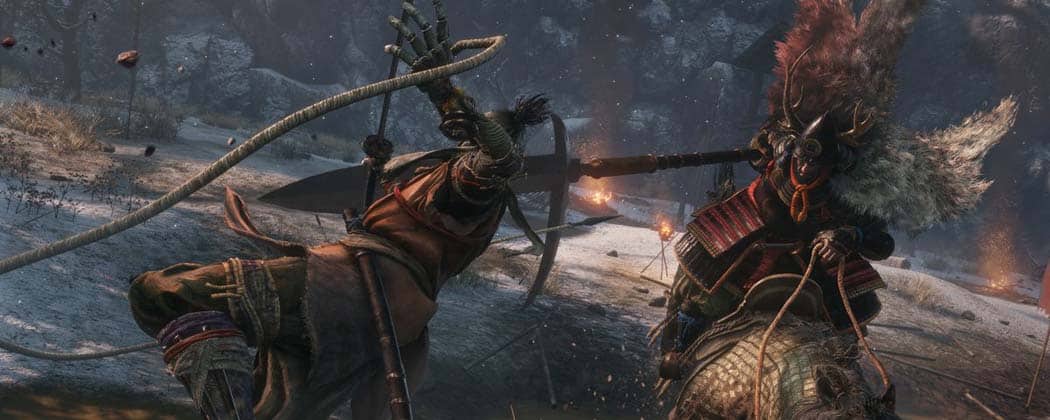
For one, there’s the usual issue of difficulty. Having spent hundreds of hours playing the Dark Souls trilogy, Demon’s Souls, Bloodborne, and having had a taste of some Souls-like clones such as Lords of the Fallen, Nioh, and The Surge, I can confidently say that Sekiro is the most challenging game of the bunch.
It could be the general fast pace of the fights, the focus on timed deflection, or just the lack of multiplayer, but one thing is sure: the game is not for everyone.
If you’ve never played a Souls-like game or you’re someone who loses their temper and patience quickly, this game is probably not for you. And if you want to get into Souls-like games, some of the earlier FromSoftware releases would probably be a better place to start.
Something that stood out to me was the hit-and-miss boss design. Sekiro has some unique, extremely memorable bosses. Still, it also has a bunch of relatively uninteresting and frustrating ones that, for some reason, the devs thought would be a good idea to re-use multiple times.
On the bright side, most minibosses are entirely skippable, though you’d be missing on some useful items if you skip them, including the prayer beads that are used to increase your health and posture.
Other than that, the only small issue that I have with this game is that the story doesn’t seem to have the same weight as that of Dark Souls or Bloodborne. Of course, this is a highly subjective observation, and some players may prefer the lack of cryptic mumbling and just how relatively straightforward the storytelling of Sekiro is.
Still, I found the immense mythology of Dark Souls and the overbearing gothic/cosmic horror of Bloodborne to be more memorable.
In any case, Sekiro: Shadows Die Twice is the kind of game that you will either love or hate, and if you have the patience, the reflexes, and the focus to cope with its many challenging encounters, you are guaranteed to love nearly every aspect of it – from its stunning vistas to the fast and visceral boss fights.

